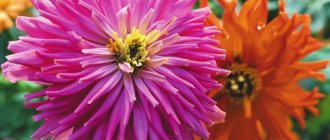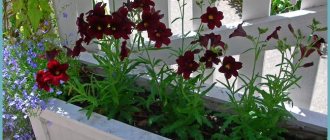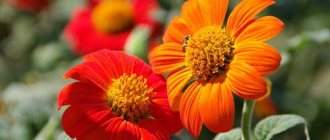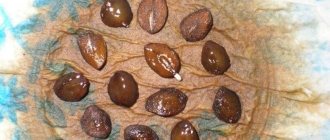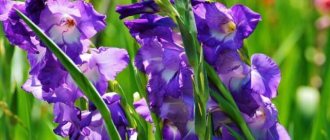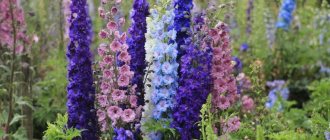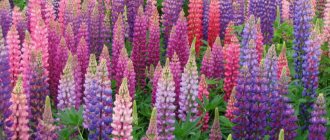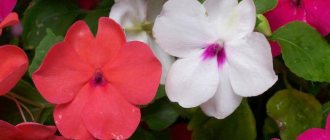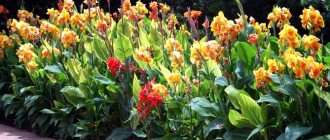Loading…
Loading…
Without the striking spike-shaped inflorescences of salvia, it is difficult to imagine flower beds in personal plots and city flower beds. Long-lasting and luxuriantly flowering plants that are not demanding on soil and watering are well known to most gardeners. But few people suspect that the genus to which Salvia splendor belongs includes several hundred species and varieties of garden salvia. Among them is sage. Plants of the genus Salvia belonging to the Lamiaceae family are found throughout the world from Europe, Eastern Siberia and Asia to the American continent. Most of them are perennials up to 120 cm high, with erect stems covered with oblong leaves and two-lipped flowers collected in spike-shaped inflorescences. Seeds of cultivated and wild plants ripen within a month after the end of flowering and can be used for planting for up to 3 years.
The leaves of many salvia varieties are elongated, whole or, much less commonly, pinnate. The color of flowers is not limited to the bright red we are used to today. This is rather an exception to the rule. Wild species amaze with their rich palette from white to deep purple, and therefore are of increasing interest to gardeners. But according to established tradition, the name “Salvia” is firmly attached to the varieties of sparkling salvia, and plants with blue tassels are often called sage.
Salvia sparkling: photo of flowers Salvia splendens
The most famous of the garden species of salvia is a native of Brazil, which has been used in culture for almost 200 years. At home, bushes or herbaceous plants with rigid, erect, tetrahedral stems can reach 20–80 cm in height and bloom en masse throughout the summer and autumn.
Before the start of active breeding work, the clusters of Salvia lucidum, photos of the flowers of which today amaze with the richness of colors and splendor of inflorescences, were not so spectacular. Gardeners had at their disposal only varieties with red corollas and calyxes, loosely sitting on the peduncle.
Today, in addition to red flowers, you can increasingly find salvia shiny white, violet-lilac, and even two-colored.
Possible problems in growing
The plant is an unpretentious flower. Not susceptible to disease, but sometimes you can find species affected by all kinds of pests.
Pests
Parasites that harm flowers include:
- Common whitefly.
- Thrips.
- Aphid.
- Mite.
- Snails or slugs.
There are a huge number of special preparations on the market that will help cope with pests. But snails and slugs can only be removed manually or using special homemade traps.
Diseases
The main factor why gardeners love salvia is its resistance to almost any disease.
Signs of improper care
Why doesn't salvia bloom? Most often, the reason is failure to comply with basic care rules. The appearance of parasites on the plant is the first sign of improper care of salvia.
If the flowers begin to turn yellow ahead of time, this means that the plant lacks trace elements. You can save the situation by watering it with any complex fertilizer.
Once having decided to plant salvia on his plot, even a novice amateur gardener will not regret his choice for a second. Just remember that caring for the salvia plant should be regular and timely.
Salvia officinalis
Medicinal salvia - sage, well known to people for thousands of years, is used in medicine, perfumery and cooking. The plant's homeland is the Mediterranean states and the Asia Minor region. In favorable conditions, the perennial subshrub reaches half a meter in height, and in Russia it can only be grown through seedlings as an annual crop.
Sage is easily distinguished by its oblong silvery leaves and purple flowers collected in sparse vertical inflorescences.
Salvia medicinal and garden varieties with variegated leaves, bloom in midsummer.
Planting sage
The choice of place for planting plants should be approached responsibly: some of them love shade and coolness, others require a large amount of light. In an improperly created environment, sage may die.
Depending on the preferred growing conditions, varieties of this herb can be divided into 2 groups:
- Cold-hardy salvias can be planted in either sun or partial shade. Some species grow better in the shade.
- Heat-loving flowers should be grown only in sufficiently lit areas. They do not require frequent watering and do not die in drought.
For planting all types of sage, it is better to choose sandy soils, because... they don't have much humus. Plants of different varieties must be placed in different sides of the garden or summer cottage, because they can interbreed. For this reason, they can reproduce using seeds.
Red Salvia (Salvia coccinea)
From the photo of the flowers, red salvia is very similar to both medicinal sage and its more spectacular relative, salvia brilliantis. The subshrub from Brazil is cultivated as an annual in European countries and Russia, but even in this case the plant grows to 50–70 cm.
This species has straight, pubescent stems with ovate leaves and carmine-red flowers, collected on sparse spike-shaped inflorescences of 5–8 pieces. The corollas, no more than 3 cm long, bloom in mid-summer, and the plant remains decorative until the coldest weather. If we compare red salvia with brilliant varieties, the former loses in brightness, although it has been used by flower growers for a hundred years longer.
Today, interest in moisture-loving salvia, which prefers sun and warmth, is constantly growing. The plant reproduces well by seeds and can be planted both in open ground and in greenhouses.
How to grow salvia from seeds
To grow healthy seedlings, gardeners need seeds, soil, container, diligence, and attention.
Preparing seeds for sowing
Since salvia seeds do not need stratification, preparation of planting material is carried out on the eve of planting. Seed material can be purchased or collected personally. Sometimes bagged goods are already pre-processed and granulated; in this case, it does not need pre-planting treatment and is sown directly into the soil.
However, it should be noted that granular seeds need to be planted a little earlier than usual, since it takes some time to dissolve the artificial mineral shell.
Simple seeds are subjected to the following treatments:
- Germination test. Place the seeds in a deep plate with warm water for 1.5 hours. Then the water with floating pacifiers is drained. High-quality seeds are collected at the bottom.
- Disinfection. The grains wrapped in a piece of bandage are kept in manganese for a third of an hour, followed by washing.
- Drying. Before planting, the seeds are dried on a sheet of paper. To prevent the core from drying out, do not place the grains on the battery.
Selection of soil mixture
If you don’t want to buy ready-made soil, it’s easy to prepare it yourself. Salvia puts forward the following requirements for it: nutritional value, lightness, water permeability.
You will need coarse sand, peat and leaf soil. A well-mixed mixture will need to be re-sowed twice:
- Place on a large sieve;
- Place in a fine sieve.
The containers are filled as follows:
- The very bottom is lined with expanded clay, approximately 1 cm thick;
- Half the container is filled with coarse soil;
- Next, add fine soil.
To destroy possible pests, the soil is watered with hot, strong potassium permanganate and left to rest for a week.
Sowing salvia seedlings in containers
Any low container is suitable for salvia seedlings. To prevent stagnation of water, the bottom is pierced several times. Ready-made factory containers already have holes and are equipped with pallets.
- The soil is pre-moistened so that the seeds stick better. Some gardeners mix salvia seeds with sand to ensure more uniform planting and prevent thickening. Granular material is larger and easier to sow, so the seeds are placed in a 3x3 pattern.
- The spread out seeds are lightly sprinkled with earth. Often gardeners simply press them lightly into the soil. The container is covered with glass or film.
Seeds germinate within 8-12 days. The temperature is maintained around +22ºС. The sprouts almost always emerge with a seed cap, and it is advisable to help them get rid of it.
How to sow salvia, the best way - video
Salvia farinacea
A picky plant that blooms from August until the end of autumn appeared in Russian flower beds from Central America. Salvia mealy has slightly branched straight stems up to 90 cm high. The inflorescences reach 20 cm in length and impressively rise above the neat pyramidal bushes.
The calyxes, corollas and the upper part of the peduncle are painted in blue or purple tones, which persist even when the plants dry.
The leaves are elongated, ovate and, unlike many types and varieties of salvia for the garden, do not have a characteristic edge.
Types and varieties
According to agrotechnical characteristics and biological characteristics, scientists divide salvia species into three groups. The first includes representatives of the American subtropics, which, for obvious reasons, are grown in our climate as annuals. These species prefer moist soil and cannot tolerate even light frosts. The first group includes:
Salvia splendens
Or Salvia shiny - from 20 to 80 cm in height, densely leafy compact bushes, leaves opposite, entire, ovate, petiolate, dark green on top and light green on the bottom of the leaf blade. Large, irregularly shaped flowers with a double perianth are collected in whorls of 2-6 pieces in racemes 14-25 cm long. Both the calyx and corolla are most often bright red, but they can also be white, purple and pink. Blooms from June until autumn frosts.
Conditions for growing celosia - everything you need to know
The sparkling white variety of salvia differs from the fiery red one in that the inflorescence is not so dense and in that the calyx looks creamy against the background of the white corolla.
Pink salvia has a shorter inflorescence than red salvia, and the corolla and calyx are the same pink color, but the corolla has a velvety texture.
In the photo: Sparkling or shiny Salvia (Salvia splendens)
Purple sparkling salvia is a very striking variety, since the deep purple color of the flowers is enhanced by their velvety feel, created by dense pubescence.
The most popular varieties of sparkling salvia: Fire Star, Red Arrows, Salvator, Sahara.
- Fritillaria or hazel grouse
Red Salvia (Salvia coccinea)
50-70 cm high, stems straight, densely pubescent and branched, leaves petiolate, ovate, finely serrate along the edges, pubescent below, glabrous above. Loose inflorescences 15-30 cm long consist of whorled flowers with a scarlet-red corolla and a long tube. This salvia blooms from July until frost. Varieties: “Lady in Red up to 40 cm high with bright red flowers, Sherry Blossom is an early variety of the same height, but with pink flowers.
In the photo: Bright red salvia (Salvia coccinea)
Salvia farinacea
A long-flowering, non-capricious plant, 60-90 cm tall, looking like a pyramidal bush. The leaves are petiolate, oblong-ovate, pubescent only along the veins, entire. Inflorescences on tall peduncles reach a length of 15-20 cm and consist of 5-28 flowers up to 2 cm long. The corolla is usually dark blue, but sometimes white. This species blooms from mid-August to late autumn. Varieties: Anschuld (silver-white flowers), Strata (compact bush with blue flowers), Victoria (lush blooming variety with dark blue flowers).
The second group consists of species of Mediterranean origin. They are more cold-resistant and drought-resistant. They grow best on loose soils and respond gratefully to mineral fertilizing.
In the photo: Salvia farinacea
Green salvia (Salvia viridis)
Or variegated salvia - in this species only the Horminum variety (var. Horminum) with brightly colored bracts is decorative. This is an annual plant 40-60 cm high with numerous straight branching stems covered with glandular fluff. The leaves are petiolate, oblong-elliptical, also pubescent. Simple inflorescences 18-30 cm long consist of false whorls with 4-6 flowers with a pink corolla, but the color of the bracts attracts the eye - juicy purple or bright pink. Varieties: White Swan (white salvia with pinkish or purple bracts), Oxford Blue with blue-violet bracts, Pink Sandy with pink bracts.
In the photo: Green or variegated salvia (Salvia viridis)
Salvia verticillata
35-40 cm high with straight or ascending densely pubescent stems, long-petioled pubescent leaves of unusual shape and flowers in dense whorls of 5-30 pieces with a lilac-blue corolla. The Purple Rain variety has flowers with a dark purple corolla and purple calyxes.
In the photo: Salvia verticillata
Salvia dandelion (Salvia taraxacifolia)
It is a herbaceous species with a basal rosette of leaves. The stems are straight, not particularly branched, all parts of the plant emit a pleasant aroma. The leaves are pinnately dissected, irregularly serrate along the edges, bare on top and pubescent on the underside of the leaf blade. Simple inflorescences up to 28 cm long consist of whorls with several flowers with a pale pink corolla, a greenish-green throat with purple specks.
In the photo: Salvia dandelion (Salvia taraxacifolia)
The second group also includes Salvia jurisicii , which is not of particular interest to gardeners.
The third group includes cold-resistant species. For the most part, these are salvias that grow in the temperate climate zone of the Old World, but Ethiopian salvia is also classified in this group. Species of the third group are characterized by abundant flowering from the second year of life. They are unpretentious, grow well in the shade and require shelter only in snowless winters.
Salvia nemorosa
Or forest salvia (Salvia sylvestris) - bushes up to 60 cm high with branched pubescent stems. The lower petiolar leaves are larger than the upper sessile leaves. Inflorescences with several pairs of lateral branches consist of false whorls with 2-6 small flowers in each. Corolla blue-violet. Large purple bracts attract the eye. Blooms from late June to early autumn. Varieties: violet-blue Mainakht, dark lavender Plumosa, pink-violet Amethyst.
In the photo: Salvia nemorosa
Salvia glutinosa
Growing beautifully in our latitudes. This is a large plant up to 90 cm in height with numerous straight glandular-pubescent stems, large long-petiolate ovate-triangular serrated leaves of a yellowish-green hue. Flowers in whorls form loose inflorescences, the corolla of the flowers is light yellow. Blooms from late summer to late autumn.
In the photo: Salvia glutinosa
Salvia x superba
Up to 60 cm in height, it blooms for a long time with blue-violet spike-shaped inflorescences. Varieties: white Salvia Snow Hill, dwarf Salvia Blue Queen and Rose Queen, respectively lavender blue and pink.
The third group also includes meadow salvia (Salvia pratensis) and the already mentioned Ethiopian salvia (Salvia aethiopis).
Salvia viridis
The value of this native of southern Europe and Asia is not in its bright inflorescences or essential oils, but in the variegated, brightly colored leaves-bracts on the upper part of 40- or 60-centimeter stems. The oblong leaves and shoots are pubescent.
The inflorescences reach 30 cm and contain up to 6 medium-sized flowers of a pinkish or light lilac hue. Salvia or sage begins to bloom in June, and the appearance of the plant is maintained throughout the growing season. The only feature that makes it difficult to use variegated forms in culture is the lodging of the stems if supports are not installed in time.
Planting and caring for salvia
- Planting: sowing seeds in open ground in spring or before winter. Seeds for seedlings are sown from mid-February to early March, and seedlings are planted in open ground at the end of May or beginning of June.
- Flowering: from June to autumn frosts.
- Lighting: bright sunlight or partial shade.
- Soil: lime-rich, light, dry, permeable.
- Watering: evening, after the top layer of soil has dried.
- Feeding: the first time - during the seedling period with a weak solution of complex mineral fertilizer, the second time - during the budding period.
- Reproduction: annual and biennial species - only by seeds, perennials - by seeds, dividing the bush and stem cuttings.
- Pests: thrips, aphids, spider mites, whiteflies, snails and slugs.
- Diseases: downy mildew, root canker, rust, powdery mildew, chlorosis, fusarium wilt, rhizoctonia.
Read more about growing salvia below.
plant (lat. Salvia) , or sage , is a numerous genus of herbaceous and shrubby perennials of the Lamiaceae or Lamiaceae family, common in tropical and temperate regions of all parts of the world except Australia. The name “salvia” is derived from the Latin “salvus”, which means “to be healthy”, and this is explained by the fact that some types of plants have been used for medicinal purposes since time immemorial. Nothing cures gumboil faster than rinsing with sage infusion.
There are only about 900 representatives of the salvia genus, and they all prefer to grow in bright places. To avoid confusion, the medicinal plant and spice are usually called sage, and ornamental plants of this genus are called salvia. And although salvia is also sage, it is used specifically for decorative purposes. Salvia officinalis has been known to people since the times of the Roman Empire, but salvia flowers were brought to Europe only in the 18th century, during the era of the horticultural boom. Separate from other species in the classification is Salvia divinorum, the so-called “predictor's sage,” or narcotic sage, from the leaves of which salvinorin, a psychoactive hallucinogen, is extracted. But in our article we will talk about salvia - an ornamental shrub.
- Plectranthus at home, care and reproduction
Salvia verticillata
The whorled variety of sage grows wild throughout Russia, Western Europe and some areas of Asia. You can recognize the few varieties of salvia by their purple flowers, collected in dense whorls located on high peduncles. The stems of this species branch only at the base and grow to a height of 50 cm. The leaves, like the shoots, are heavily pubescent and attached to the stems on long petioles.
Whorled salvia begins to bloom in July, and until September you can see its elegant inflorescences in forest glades and garden plots.
How to care for salvia seedlings after planting
High-quality and complete care is extremely important both before emergence and after. In the first case, it will help the seeds to germinate safely in the ground, and in the second, it will help to grow normal, strong and healthy seedlings. So, you need to care for salvia as follows:
- Maintain optimal temperature . Immediately after sowing the seeds, you need to move the box to a room where the temperature is stably maintained at 22-25 degrees Celsius.
- Monitor the optimal humidity until seedlings emerge - that is, ventilate the mini-greenhouse daily, removing the glass or film for a short time (about 20 minutes). In this case, you need to wipe the covering material with a rag to remove condensation and avoid excessive moisture.
- Immediately after the first shoots appear, you need to remove the lid or glass ; they will no longer be useful.
- Full lighting is extremely important for young plants. As soon as the seedlings appear, it is necessary to move the crops to a windowsill well lit by the sun (preferably southern or southwestern). The optimal length of daylight is at least 12 hours, so if necessary, you need to add additional lighting with lamps.
- Don't forget about regular watering , which young plants so need. Before emergence, you need to spray the soil with a spray bottle. After the shoots appear, you can water from a small watering can or other vessel, but do it carefully; when watering, the water should not get on the plant! You need to water as the soil dries out (approximately once every three to five days), and clean, settled water at room temperature should be used! And remember that you should not allow the soil to dry out or become waterlogged (there is a risk of blackleg).
- Fertilizers are very useful . For example, you can use fertilizer “Fertika”, “Agricola”. It is recommended to feed the seedlings only twice: the first time - two weeks after picking, and the second time seven days after the first feeding.
Clary sage (Salvia sclarea)
Powerful meter-tall plants are grown in annual or biennial crops. On straight stems covered with oblong leaves, serrated along the edges. This type of salvia produces abundant green mass. The leaves sometimes reach a length of 30 cm, but as they move towards the inflorescence they become smaller.
What makes the plant decorative is not the inconspicuous flowers, but the leaves-bracts. Today there are varieties of salvia with white, pink or purple corollas. Blooming from June to September, the sage species is well known as a valuable medicinal and essential oil plant.
Description of Salvia shiny
The genus Salvia or sage gets its name from the Latin "salvare", which literally means "to save, to protect."
But only some species that live in forests and meadows are endowed with medicinal properties. Salvia sparkling or shiny, growing in flower beds, does not contain any medicinal substances, and owes its popularity to its beautiful appearance. Decorative species were brought to Europe back in the 18th century and they are still in great demand among gardeners. It’s simply impossible to pass by the Salvia shiny and not pay attention to it. A tall flower resembling a pyramid stands out as a bright spot among other plants. Although it is a perennial, in countries with a temperate continental climate it is cultivated for one season, since the sparkling salvia comes from warm regions and is simply not able to withstand a harsh winter.
Salvia flowering
- The height of the plant is 25-80 cm. At the same time, almost half is occupied by the flower spikelet.
- The stem is erect, the leaves are entire. Located on petioles opposite each other.
- By nature it is a perennial, but in mid-latitudes it is grown as an annual plant.
- Salvia has a long growing season - about 100-120 days.
- The flowers are tube-shaped, two-lipped, collected in spike-shaped inflorescences, pyramid-shaped, which can reach a height of 20 cm.
- Thanks to the work of breeders, the color of sparkling salvia flowers can be orange, red, salmon, burgundy, dark purple, pink and white.
- Flowering begins in June and ends after frost.
- The salvia fruit consists of four nuts.
- The seeds are suitable for sowing a month after the flowers open. Able to remain viable for up to 5 years.
Salvia (Salvia pratensis)
The half-meter-tall plant is distinguished by many straight, branching stems and flower stalks strewn with purple corollas. Meadow sage is similar to oak salvia, but the latter is much more powerful, and its shoots are not so branched. Each whorl contains from 4 to 6 flowers; occasionally small leaves can be seen on the stems, which become much larger towards the basal rosette.
Meadow sage blooms in two waves. The first, like many species and varieties of salvia for the garden, begins in June, and the second flowering revitalizes the area in September.
Pests and diseases of salvia
Salvia is extremely resistant to fungal diseases, but it is useless to fight viral or bacterial diseases; you just need to remove the affected plants from the area and prevent the development of these infections using agrotechnical and preventive methods. As for pests, salvia can suffer from aphids, whiteflies and spider mites, especially if the flower garden is located close to vegetable beds. Plants are treated with insecticidal preparations against aphids and whiteflies, and acaricides are used to get rid of spider mites.
Salvia leaves can be damaged by slugs and snails. To protect plants from mollusks, pieces of bark or slate are laid out around the area, which will make it difficult for pests to move, and a small ditch is made around the flowerbed and filled with large crushed stone. You can also catch slugs with bait: dig a glass jar into the ground, literally flush with the surface, and fill it a third with beer or a fermented sweet drink - juice, compote, honey water. Once trapped in a jar, slugs will no longer be able to get out of it.
